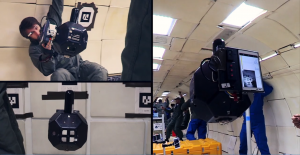

The benefit of these robotic platforms is to assist astronauts and even execute basic maintenance in space, all by having 3D maps that are ‘machine readable’. As you can see in the video, the robots are test flying around in zero gravity in the International Space Station (ISS), with intent to be “individuals” via Google’s technology. Google’s Tango smartphone is a huge part of how the SPHERES will work in space. The phone has the ability to view the world in 3D, as humans do, all by “measuring depth, observing movement, and essentially understanding the space it occupies”. Tango is better explained by recent teardown video. The hardware is occupied by a pair of cameras, and an infrared (IR) projector. One camera is for black and white imaging, while the other is for color, and IR. Finally, NASA’s SPHERES robots are plugged into Tango, allowing the robot’s “eyes” to view its own surroundings. The genius is the new found ability for robots to avoid bumping into anything, meaning higher productivity with humans inside the ISS.
Sources say the ultimate plan (once deployed this summer) is for the robots to construct a 3D map of the ISS, where they will individually navigate it. As stated in a recent Google+ post, this means the SPHERES could, “for the first time in history, enable autonomous navigation of a floating robotic platform 230 miles above the surface of the Earth”. Undoubtedly, we will see Project Tango smartphones implemented in many creative ways once developers become involved. This is just the beginning, and according to ATAP software engineer Joel Hesch, “If you can do sensor fusion and perception on a mobile phone, you can enable so many use cases that can be used on other devices like SPHERES, that benefit the lives of people, that can really impact in a way that wasn’t possible before”.

 Laptop & Tablet Parts
Laptop & Tablet Parts




















